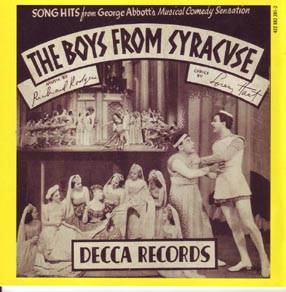The play is usually treated as being beneath the glorious Shakespeare because of its reliance on farcical absurdity for the humor and because, on the assumption that it’s among the first comedies Shakespeare wrote, it lacks the organic originality of other of his plays. It “evokes no sense of the inexhaustibility that characterizes Shakespeare’s masterpieces” (Goddard I 25), and is “a product of Shakespeare’s intellect rather than of his imagination” (26). The play is considered more artificial than its Latin source: Plautus’ Manaechmi from about 220 BCE, “a Roman farcical comedy which he [Shakspere] may have read at school in the original Latin” (Wells 54) — give me a flipping break. Shakespeare added elements from Plautus’ Amphitruo such as the dinner and the second set of twins (Garber 163).
But the thing is a delight. The verse often rhymes, making the play zip along (it’s the shortest of the plays anyway), and a good production can make the experience exhilarating. For further compactness, like only The Tempest in the Shakespeare canon it obeys the Aristotelian unities (Asimov 179). The Rodgers and Hart musical, The Boys from Syracuse, comes from this play.
We know that a play called The historie of Error was shown at Hampton Court on New Year’s Day 1576-77, which sounds like an early version of the one we’ve got (Clark 15, Ogburn 582, Anderson 124). This dating doesn’t work for the Stratfordians, of course, who insist on a 1594 showing as pivotal, but it works fine for the Oxfordian thesis. The play certainly seems like a court entertainment, perhaps with later touches added (Clark 15; Ogburn and Ogburn 111). The elder Ogburns suggest that an even earlier version originated in the early 1570s, from Oxford’s days at Gray’s Inn (Ogburn and Ogburn 110-111).

The Comedy of Errors, Act by Act
The Comedy of Errors Introduction
Further Resources
Filmography
The Comedy of Errors. 1978.
The Comedy of Errors. 1983.
The Comedy of Errors.
Best Editions
Bevington, David, ed. The Complete Works of Shakespeare. 6th ed. Pearson Education Inc., 2009. 2-30.
Cartwright, Kent, ed. The Comedy of Errors. The Arden Shakespeare. 3rd Series. London: Bloomsbury Publishing, 2016.
Delahoyde, Michael, ed. The Comedy of Errors. The Oxfordian Shakespeare Series, 2025.
Oxfordian Resources
Clark, Eva Turner. Hidden Allusions in Shakespeare’s Plays. 3rd ed. by Ruth Loyd Miller. Port Washington: Kennikat Press, 1974. 15-29.
Delahoyde, Michael, ed. “The Shakespeare Guide to The Comedy of Errors.” By Richard Paul Roe. The Shakespeare Oxford Newsletter 59.1 (Winter 2023): 1, 23-25.
Farina, William. De Vere as Shakespeare: An Oxfordian Reading of the Canon. Jefferson, NC: McFarland and Co., 2006. 40-43.
Gilvary, Kevin. Dating Shakespeare’s Plays. Tunbridge Wells, UK: Parapress, 2010. 83-90.
Ogburn, Charlton. The Mysterious William Shakespeare: The Myth & The Reality. 2nd ed. McLean, VA: EPM Publications, Inc., 1992.
Ogburn, Dorothy and Charlton Ogburn. This Star of England. Westport, CT: Greenwood Press, Pub., 1952. Esp. 110-114.
And Other General Resources
Goddard, Harold C. The Meaning of Shakespeare. Vol. 1. Chicago: The University of Chicago Press, 1951. 25-27.
Smidt, Kristian. Unconformities in Shakespeare’s Early Comedies. NY: St. Martin’s Press, 1986. 26-38. Smidt finds numerous time discrepancies suggesting significant revision.
Shakespeare Authorship Organizations
The Shakespeare Foundation. Dir. Alan W. Green. The sponsor of Shakespeare Illuminated. You say you want a revolution. Well….
The De Vere Society. Our Oxfordian friends and collaborators across the pond.
The Shakespeare Oxford Fellowship. Browse, get hooked, become a member. Tell them I sent you.
The Shakespeare Authorship Roundtable. We consider all possible authors behind the “Shakespeare” name.